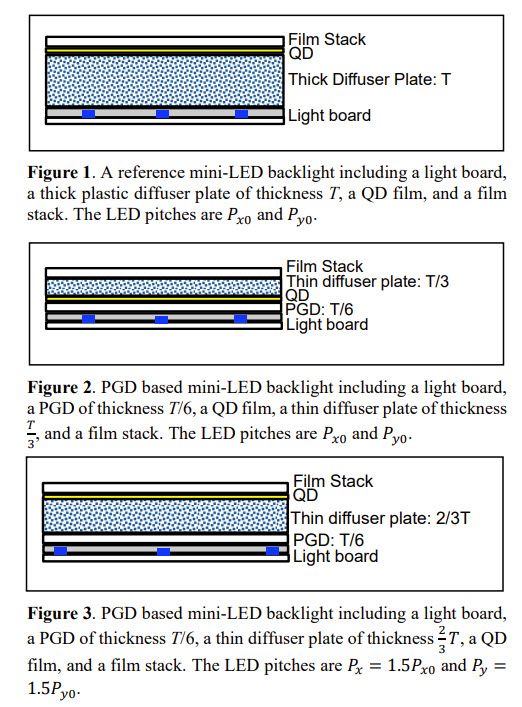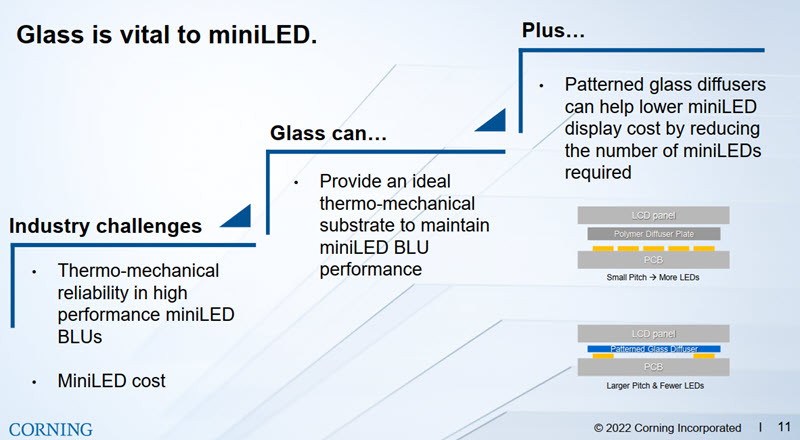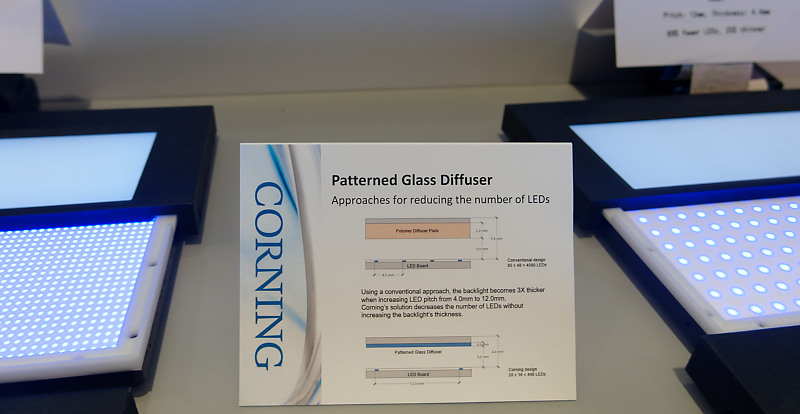At the SID/DSCC Business Conference, Corning’s Han Yim explained how the company continues to look for ways to exploit the properties of its glass in LCDs and OLEDs. In particular, he highlighted the use of a glass diffuser in an LCD to reduce the number of LEDs needed in a miniLED BLU.

The use of glass can also reduce the thickness of the diffuser as well as offering better flatness. There is a trade-off. You can use the same number of LEDs and reduce thickness, or accept less thickness reduction and reduce the number of miniLEDs. We got a chance to see the diffuser on the firm’s booth in the Display Week exhibition area and also found a paper (64.3 X.-D. Mi Patterned Glass Diffuser for MiniLED Count Reduction) that gave more background. In the paper, the firm, along with BOE, showed how it had developed a design that used 5,000 fewer LEDs in the BLU than a reference design based on a plastic diffuser, with the same uniformity and luminance. It is half the thickness of the reference.
The Patterned Glass Diffuser (PGD) is a glass plate with a pattern on one or both sides and that can cause diffusion via multiple reflections. The patterns can be variable (VDP) or uniform (UDP). The main purpose of the VDP is to move light away from the LED to spread it further as long as the LED and the pattern are correctly aligned. However, the UDP is used to get a more Lambertian distribution of the light from the surface if it is on the back of the glass, or to allow bigger tolerances when on the front.
 Corning tried three configurations – the top is the reference – the second is thickness/2 and the third uses fewer miniLEDs
Corning tried three configurations – the top is the reference – the second is thickness/2 and the third uses fewer miniLEDs
The tests that Corning and BOE did also used QD films in the optical stack and the firms developed a model for the structures to allow analysis. The company also used a Fourier transform to help to understand how much the pattern of LEDs would be visible (in most miniLED sets, there are multiple LEDs in a zone). This was checked with samples as the eye is so sensitive to this kind of issue. As a result, the researchers have established a good metric to predict the visibility of LED patterns.
The group worked out the optimum pattern to use and were able to achieve 90% uniformity – to match the reference design. The researchers also looked at colour uniformity and found that the CIE 1931 chromaticity coordinates x and y are typically within 0.02 relative to the reference backlight.
An interesting aspect was better local dimming control. If you increase the pitch of the LEDs (with fewer in the backlight) you change the control quality, but if you use the same pitch of LEDs, the control with the PGD is better, with an alternating On/Off pattern. (This was shown in a 2021 paper on the topic by the companies [46-1 / X.-D. Mi – Patterned Glass Diffuser (PGD) for MiniLED Backlights]. The 2021 paper focused on reducing the thickness of the diffuser rather than trying to reduce the number of LEDs.
As well as reduced thickness, a glass diffuser has around one tenth of the coefficient of expansion of plastic and a much smaller humidity swell (nearly 0). That makes mechanical design simpler when trying to get to high levels of brightness, especially where a slim design is desired.
Further work will continue to develop and optimise the PGD concept to further improve the luminance efficiency.
Corning initially was positioning the glass diffuser as potentially being an encapsulant layer for the QD layer, but with the latest Nanosys materials not needing an expensive barrier layer, that is less of a factor now. (BR)




